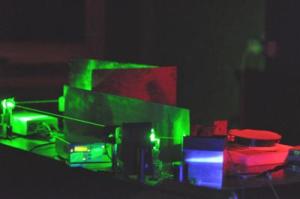The quantum computers of tomorrow might use photons, or particles of light, to move around the data they need to make calculations, but photons are tricky to work with.
Two new papers by researchers working at the National Institute of Standards and Technology (NIST) have brought science closer to creating reliable sources of photons for these long-heralded devices.
 Gated photon source starts with the bright green 532nm wavelength laser beam that strikes a crystal (bright green spot, center) and is converted into pairs of photons at 810nm (false colored blue here, it's at the end of the red spectrum) and 1550nm (in the infrared, false colored red here.). The "blue" beam is the herald channel, the "red" beam goes through a spool of optical fiber (right) to delay it long enough for the ga6te to open or shut.
Gated photon source starts with the bright green 532nm wavelength laser beam that strikes a crystal (bright green spot, center) and is converted into pairs of photons at 810nm (false colored blue here, it's at the end of the red spectrum) and 1550nm (in the infrared, false colored red here.). The "blue" beam is the herald channel, the "red" beam goes through a spool of optical fiber (right) to delay it long enough for the ga6te to open or shut.
In principle, quantum computers can perform calculations that are impossible or impractical using conventional computers by taking advantage of the peculiar rules of quantum mechanics. To do this, they need to operate on things that can be manipulated into specific quantum states. Photons are among the leading contenders.
The new NIST papers address one of the many challenges to a practical quantum computer: the need for a device that produces photons in ready quantities, but only one at a time, and only when the computer's processor is ready to receive them. Just as garbled data will confuse a standard computer, an information-bearing photon that enters a quantum processor together with other particles—or when the processor is not expecting it—can ruin a calculation.
The single-photon source has been elusive for nearly two decades, in part because no method of producing these particles individually is ideal. "It's a bit like playing a game of whack-a-mole, where solving one problem creates others," says Alan Migdall of NIST's Optical Technology Division. "The best you can do is keep all the issues under control somewhat. You can never get rid of them."
The team's first paper addresses the need to be certain that a photon is indeed coming when the processor is expecting it, and that none show up unexpected. Many kinds of single-photon sources create a pair of photons and send one of them to a detector, which tips off the processor to the fact that the second, information-bearing photon is on its way. But since detectors are not completely accurate, sometimes they miss the "herald" photon—and its twin zips into the processor, gumming up the works.
The team effort, in collaboration with researchers from the Italian metrology laboratory L'Istituto Nazionale di Ricerca Metrologica (INRIM), handled the issue by building a simple gate into the source. When a herald photon reaches the detector, the gate opens, allowing the second photon past. "You get a photon when you expect one, and you don't get one when you don't," Migdall says. "It was an obvious solution; others proposed it long ago, we were just the first ones to build it. It makes the single photon source better."
In a second paper, the NIST team describes a photon source to address two other requirements. Quantum computers will need many such sources working in parallel, so sources must be able to be built in large numbers and operate reliably; and so that the computer can tell the photons apart, the sources must create multiple individual photons, but all at different wavelengths. The team outlines a way to create just such a source out of silicon, which has been well-understood by the electronics industry for decades as the material from which standard computer chips are built.
"Ordinarily a particular material can produce only pairs in a specific pair of wavelengths, but our design allows production of photons at a number of regular and distinct wavelengths simultaneously, all from one source," Migdall says. "Because the design is compatible with microfabrication techniques, this accomplishment is the first step in the process of creating sources that are part of integrated circuits, not just prototype computers that work in the hothouse of the lab."
Source: http://www.nist.gov/